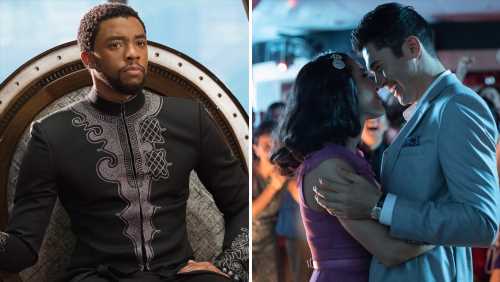The year of 2018 saw huge strides in diversity and inclusion in film — mainly because of the release of Marvel Studios’ Black Panther and the Warner Bros. rom-com Crazy Rich Asians. Although both features broke ground and were a watershed moment for the Black and Asian communities, it doesn’t mean everything is hunky-dory with the representation of underrepresented and marginalized communities in film. A new report from Professor Stacy L. Smith and the Annenberg Inclusion Initiative at USC’s Annenberg School for Communication and Journalism shows that there has been improvement toward inclusion but the needle could and should be moved more.
The report, which comes shortly after the Inclusion Initiative’s Latinx study with NALIP, took a comprehensive look at film examining 53,178 characters in 1,200 top films from 2007 to 2018. The numbers proved that things are definitely looking up.
Related Story
New Hollywood Podcast: Isaiah Mustafa Talks 'It: Chapter Two', Scary Clowns and Being Known As "The Old Spice Guy"
In 2018, 39 of the 100 top films had a female in a leading or co-leading role. This is a jump from 2017 when 33 films had a lead or co-lead female actor. It is also a gigantic leap from 2007 when the number was a mere 20.
The report also found that in 2018 there were 27 movies with leading or co-leading roles that featured characters from underrepresented racial/ethnic groups. This was another boost from 2017 where there were only 21 films. In addition, the films in the study showed that 11 films featured a female lead from an underrepresented racial/ethnic group compared to just four in 2017, and 11 movies were led by a female actor age 45 or older, versus five in 2017.
Breaking it down even more, the report took a look at speaking characters in the films studied. There was a 12-year high in the percentage of Black and Asian speaking characters — which is probably because of Black Panther and Crazy Rich Asians. Even so, the analysis fell short of a five percentage point difference from 2007. One explanation for the increase in Black characters can be found behind the camera, as the number of Black directors rose from six in 2017 to 15 across the 100 top movies of 2018. This further proves that inclusion behind the camera could fuel the need inclusion in front of it.
2018 was definitely a good year as the percentage of characters from underrepresented racial/ethnic groups rose from 29.3% in 2017 to 36.3%. This was the same story for the percentage of female and underrepresented speaking characters in action/adventure films.
“In 2018 we saw companies taking steps to ensure that certain groups were included in some of their most notable movies,” said Dr. Smith. “While we are pleased to see progress in some areas, efforts cannot end here. There are several arenas where much more growth is needed.”
Broadly speaking, this was the good news. The not-so-good news came after further unpacking the analysis and looking through a more intersectional lens. There seems to be little to no change in the representation of female characters. Female speaking characters on screen filled just 30.9% of all roles across the 12-year time frame. To add to that, only 33.1% of roles in the 100 top movies of 2018 went to female characters. This nearly matched the 31.8% in 2017.
The study also found the 100 top films of 2018 didn’t have much representation when it came to the disabled and the LGBTQ community. Of the top films of 2018, representation for disabled characters was at a 1.6%, a four-year low. The number was lower for the LGBTQ community which only had 1.3% representation of queer characters in the films of 2018 — and this is after there was an uptick in 2017. The number of transgender characters on screen was practically non-existent as there was only one between 2014 and 2017.
In an “invisibility analysis”, the report does exactly that: they tally up how many movies are missing female characters from different groups. The results showed that of the 100 top films of 2018, that 33 films were missing Black/African American female characters, 54 were missing Asian or Asian American female characters, 70 Latina characters, and 51 girls or women from multiracial backgrounds. Other groups excluded were American Indian/Alaskan Native female characters (99 movies), female Native Hawaiian/Pacific Islanders (97 movies), and Middle Eastern/North African girls and women (92 movies). On top of that 83 films did not portray a single female character with a disability and 89 were devoid of even one female LGBTQ representation.
“These numbers reveal the depth of the erasure of female characters, particularly those from underrepresented racial/ethnic backgrounds, the LGBTQ community, and individuals with disabilities,” said Marc Choueiti, Program Director at the Annenberg Inclusion Initiative. “As we continue to monitor the most popular films released each year, these numbers are one place we will continue to scrutinize for change.”
In addition to the boatload of data and analysis from Dr. Smith’s team mentioned above, the report dove deeper with its examination of how characters were depicted on screen including parenting, their relationships with others and sexualization. It seems like there was even more disservice done to female characters as they were more than twice as likely as male characters to be shown in sexually revealing clothing or seen as attractive. In the top films from 2018, teenage (13-20) and young adult (21-39) females were equally likely to be sexualized.
The report served up some solutions which focused on casting lead roles, small parts, and hiring behind the camera. “There are opportunities across the entertainment ecosystem to create lasting change,” Dr. Smith said. “By employing targeted solutions, we can ensure that all individuals are seen and heard in some of our most iconic stories.”
The entire Annenberg Inclusion Initiative report can be read here.
Source: Read Full Article








